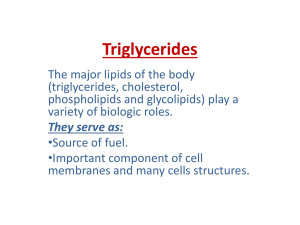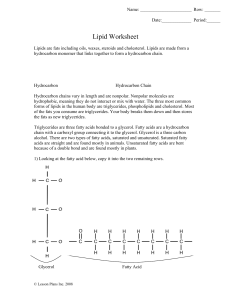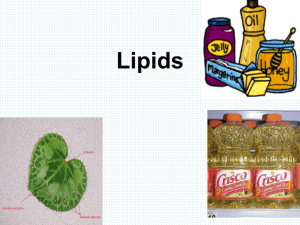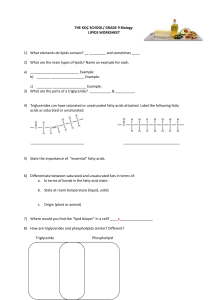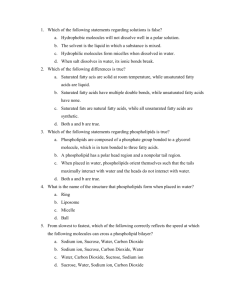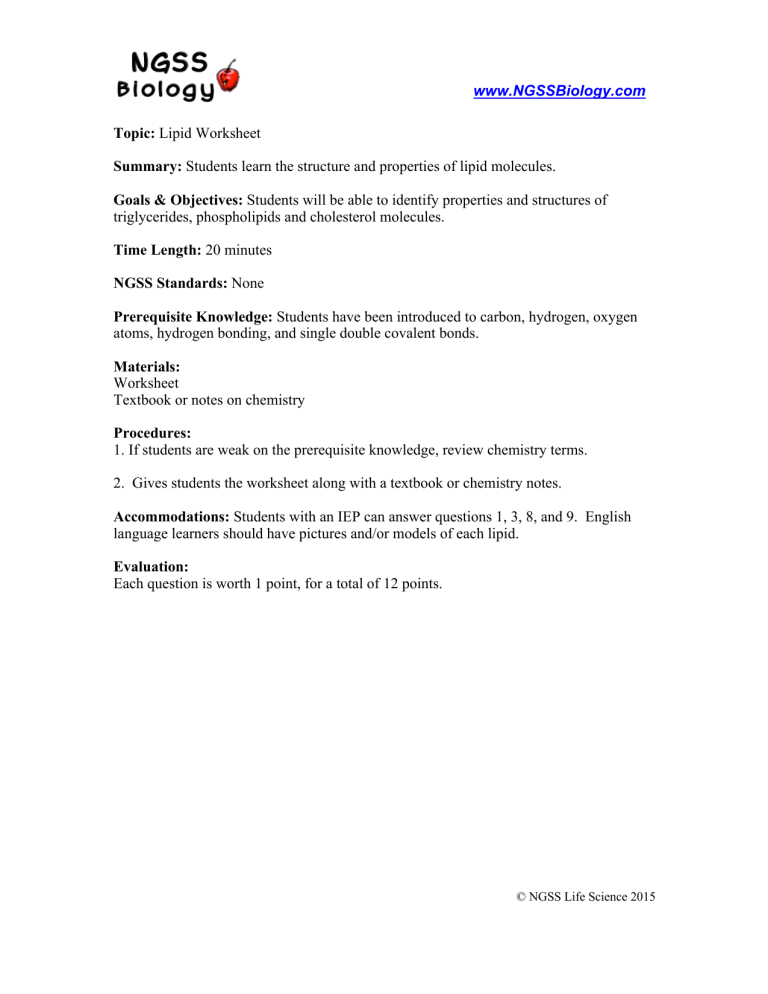
www.NGSSBiology.com Topic: Lipid Worksheet Summary: Students learn the structure and properties of lipid molecules. Goals & Objectives: Students will be able to identify properties and structures of triglycerides, phospholipids and cholesterol molecules. Time Length: 20 minutes NGSS Standards: None Prerequisite Knowledge: Students have been introduced to carbon, hydrogen, oxygen atoms, hydrogen bonding, and single double covalent bonds. Materials: Worksheet Textbook or notes on chemistry Procedures: 1. If students are weak on the prerequisite knowledge, review chemistry terms. 2. Gives students the worksheet along with a textbook or chemistry notes. Accommodations: Students with an IEP can answer questions 1, 3, 8, and 9. English language learners should have pictures and/or models of each lipid. Evaluation: Each question is worth 1 point, for a total of 12 points. © NGSS Life Science 2015 Name: _______________________ Row: _______ Date:_____________ Period:______ Lipid Worksheet Lipids are fats including oils, waxes, steroids and cholesterol. Lipids are made from a hydrocarbon monomer that links together to form a hydrocarbon chain. Hydrocarbon Hydrocarbon Chain Hydrocarbon chains vary in length and are nonpolar. Nonpolar molecules are hydrophobic, meaning they do not interact or mix with water. The three most common forms of lipids in the human body are triglycerides, phospholipids and cholesterol. Most of the fats you consume are triglycerides. Your body breaks them down and then stores the fats as new triglycerides. Triglycerides are three fatty acids bonded to a glycerol. Fatty acids are a hydrocarbon chain with a carboxyl group connecting it to the glycerol. Glycerol is a three carbon alcohol. There are two types of fatty acids, saturated and unsaturated. Saturated fatty acids are straight and are found mostly in animals. Unsaturated fatty acids are bent because of a double bond and are found mostly in plants. 1) Looking at the fatty acid below, copy it into the two remaining rows. Glycerol Fatty Acid 2) Fatty acids are composed of a carboxyl group and ____________________________. © NGSS Life Science 2015 3) What are the four parts of a triglyceride? _____________ & 3 __________________ 4) The human body stores fats as __________________________. 5) Label the following fatty acids as saturated or unsaturated. ____________________ _____________________ 6) When a hydrocarbon chain is bent, it is called _______________________________. Phospholipids are similar to triglycerides except that a phosphate group replaces one of the fatty acids. The phosphate group is a polar molecule. Polar molecules are hydrophilic and interact with water. 7) Fill in one the remaining fatty acid below. Label all the parts. Phosphate Group © NGSS Life Science 2015 The common form of a phospholipid looks like a circle with two tails. Phospholipids are polar on the phosphate group side and nonpolar on the fatty acid side. When one phospholipid is next to another phospholipid, they line up with the heads on one side and the tails on the other side. Two rows of phospholipids are called a lipid bilayer and they make up the membranes of all cells. Phosphate Group Head Fatty Acid Tails Lipid Bilayer 8) Below, label which parts are polar and nonpolar. 9) Where would you find the lipid bilayer in a cell? _____________________________ Cholesterol has a different shape in that it forms rings instead of hydrocarbon chains. Cholesterol is found only in animals in: body tissues, cell membranes and blood. All steroid hormones (testosterone, estrogen, and progesterone) are derived from cholesterol. 10) What lipid do animal cells have inside their cell membranes? __________________ 11) What does hydrophobic mean? __________________________________________ 12) What are steroid hormones made from? ____________________ © NGSS Life Science 2015
